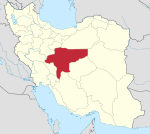Garkan-e Shomali Rural District
Persian: دهستان گركن شمالي | |
|---|---|
| Coordinates: 32°28′45″N 51°35′39″E / 32.47917°N 51.59417°E[1] | |
| Country | Iran |
| Province | Isfahan |
| County | Falavarjan |
| District | Pir Bakran |
| Capital | Pir Bakran |
| Population (2016)[2] | |
| • Total | 15,115 |
| Time zone | UTC+3:30 (IRST) |
Garkan-e Shomali Rural District (Persian: دهستان گركن شمالي)[3] is in Pir Bakran District[a] of Falavarjan County, Isfahan province, Iran.[5] It is administered from the city of Pir Bakran.[6]
Demographics
[edit]Population
[edit]At the time of the 2006 National Census, the rural district's population was 16,050 in 4,292 households.[7] There were 16,500 inhabitants in 4,838 households at the following census of 2011.[8] The 2016 census measured the population of the rural district as 15,115 in 4,839 households. The most populous of its 34 villages was Dargan, with 2,409 people.[2]
See also
[edit]Notes
[edit]References
[edit]- ^ OpenStreetMap contributors (12 June 2023). "Garkan-e Shomali Rural District (Falavarjan County)" (Map). OpenStreetMap (in Persian). Retrieved 12 June 2023.
- ^ a b "Census of the Islamic Republic of Iran, 1395 (2016)". AMAR (in Persian). The Statistical Center of Iran. p. 10. Archived from the original (Excel) on 19 October 2020. Retrieved 19 December 2022.
- ^ Iranian National Committee for Standardization of Geographical Names website (in Persian)
- ^ Habibi, Hassan. "Changing the name of Garkan-e Shomali District under Falavarjan County of Isfahan province to Pir Bakran District". Lamtakam (in Persian). Ministry of Interior, Council of Ministers. Archived from the original on 6 February 2024. Retrieved 6 February 2024.
- ^ Habibi, Hassan (21 June 1369). "Approval of the organization and chain of citizenship of the elements and units of the national divisions of Isfahan province, centered in the city of Isfahan". Lamtakam (in Persian). Ministry of Interior, Defense Political Commission of the Government Board. Archived from the original on 4 February 2024. Retrieved 4 February 2024.
- ^ Mousavi, Mirhossein. "Creation and formation of five rural districts including villages, farms and places in a part of Falavarjan County under Isfahan province". Research Center of the System of Laws of the Islamic Council of the Farabi library of Mobile Users (in Persian). Ministry of Interior, Council of Ministers. Archived from the original on 27 April 2013. Retrieved 6 February 2024.
- ^ "Census of the Islamic Republic of Iran, 1385 (2006)". AMAR (in Persian). The Statistical Center of Iran. p. 10. Archived from the original (Excel) on 20 September 2011. Retrieved 25 September 2022.
- ^ "Census of the Islamic Republic of Iran, 1390 (2011)". Syracuse University (in Persian). The Statistical Center of Iran. p. 10. Archived from the original (Excel) on 17 January 2023. Retrieved 19 December 2022.


Well, that’s interesting to know that Psilotum nudum are known as whisk ferns. Psilotum nudum is the commoner species of the two. While the P. flaccidum is a rare species and is found in the tropical islands. Both the species are usually epiphytic in habit and grow upon tree ferns. These species may also be terrestrial and grow in humus or in the crevices of the rocks.
View the detailed Guide of Psilotum nudum: Detailed Study Of Psilotum Nudum (Whisk Fern), Classification, Anatomy, Reproduction